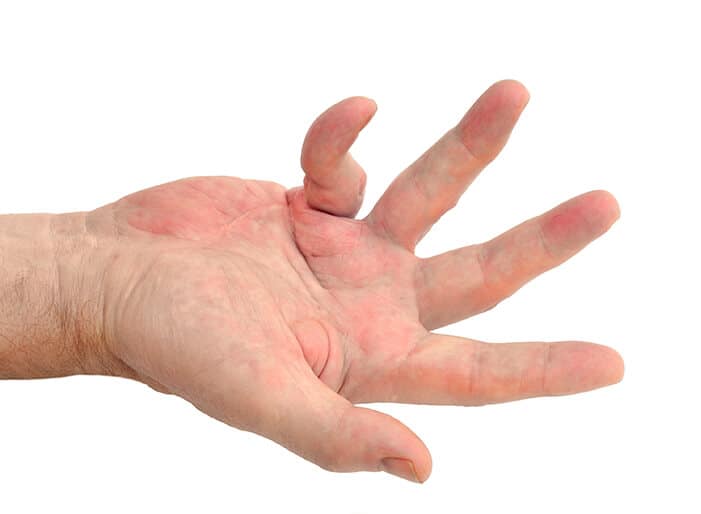Dupuytren’s Contracture
Dupuytren’s contracture is a condition that affects the nodules and cords of connective tissue, or palmar fascia, to the palm. The fascia contains strands of fibers, like cords, that run from the palm upward into the fingers. In Dupuytren’s contracture, the tightening of the tissue causes the fingers to become bent down, which may become permanent if not treated. The tightening usually starts on the pinky finger and then travels down to the thumb as time goes on. This can make it difficult to grasp large objects and make simple movements like washing your face or putting on gloves. Because the thumb and index finger aren’t usually involved, the condition usually doesn’t affect your ability to write and grasp small objects.
What causes Dupuytren’s contracture?
The cause of Dupuytren’s contracture is still unknown, but it tends to run in families, so it may be genetic.

Who is at risk of getting Dupuytren’s contracture?
Dupuytren’s contracture is more common in middle age men of Northern European descent. Alcohol and tobacco use, diabetes, and epilepsy increase the risk of the disease.
What are the symptoms of Dupuytren’s contracture?
Common symptoms of Dupuytren’s contracture include nodules in the palm, fingers bent down toward palms, and difficulty straightening fingers and using hands.
Although Dupuytren’s isn’t always painful, the nodules in the palm may be sensitive to touch. As the condition slowly progresses over the years, thickened tissue causes your ring and pinky fingers to curl in toward your palm, restricting the movement of your fingers. The bending caused by thick tissue is called contracture.

How is Dupuytren’s contracture diagnosed?
Your hand doctor will ask you questions about your medical history and then examine your hand, feeling for thickened scar tissue and seeing whether your fingers pull inward. Your doctor may also ask you to lay your hand, palm down, on a table to see if it lies flat, and will test your grip and range of motion of your fingers–all to see if you have a contracture.
What treatments are available for Dupuytren’s contracture?
There is no cure for Dupuytren’s contracture; however, the condition is treatable. If the condition is progressing slowly, you feel no pain, and it has little impact on your ability to use your hands for everyday tasks, you don’t need treatment, just monitoring.
If, however, your condition has progressed to where it is impacting your ability to use your hands, there are both nonsurgical and surgical options available for treating Dupuytren’s contracture.
Nonsurgical Treatment
The choice of nonsurgical treatment depends on the severity of your symptoms and other health problems you may have. Some of the options include:
Medication. Corticosteroid injections help reduce swelling and inflammation. They can help ease pain and prevent finger contractures from getting worse. They won’t, however, help to straighten your finger if you already have a contracture.
Needling. A needle is inserted through your skin to puncture and break the cord of tissue that is contracting a finger. There is no incision required for this technique, and it can be done on several fingers at the same time. The disadvantage of this option is that it can’t be used in some places in the finger because it could damage a nerve or tendon.
Enzyme Injections. An enzyme (FDA-approved collagenase Clostridium histolyticum, Xiaflex) is injected into the taut cord in your palm to soften and weaken it allowing your doctor to later manipulate your hand in an attempt to break the cord and straighten your fingers.
Surgical Treatment
In most cases, minimally invasive surgery is the best option for Dupuytren’s contracture. During the procedure, your hand surgeon removes the thickened tissue in your palm, which allows the fingers to move again.
Surgery is an important consideration, as the contracture is often recurring, and surgery offers patients a more complete and longer-lasting release than that provided by needle or enzyme methods.
What can you expect after surgery for Dupuytren’s contracture?
After surgery, your hand surgeon will recommend physical therapy (hand therapy) for several months. Physical therapy will help you regain strength and movement in your fingers.
Dupuytren’s Contracture Treatment in Fremont, California
If you are experiencing any symptoms of Dupuytren’s contracture, contact FORM Hand, Wrist & Elbow at (510) 480-3700 to schedule a consultation with Dr. Besh. Dr. Besh is an expert in upper extremity and hand conditions. He is fellowship-trained and has a subspecialty certificate in surgery of the hand. Your hands should be cared for by an expert with over 15 years of focused experience in orthopedic hand conditions. For your convenience, you may also request a consultation online.
